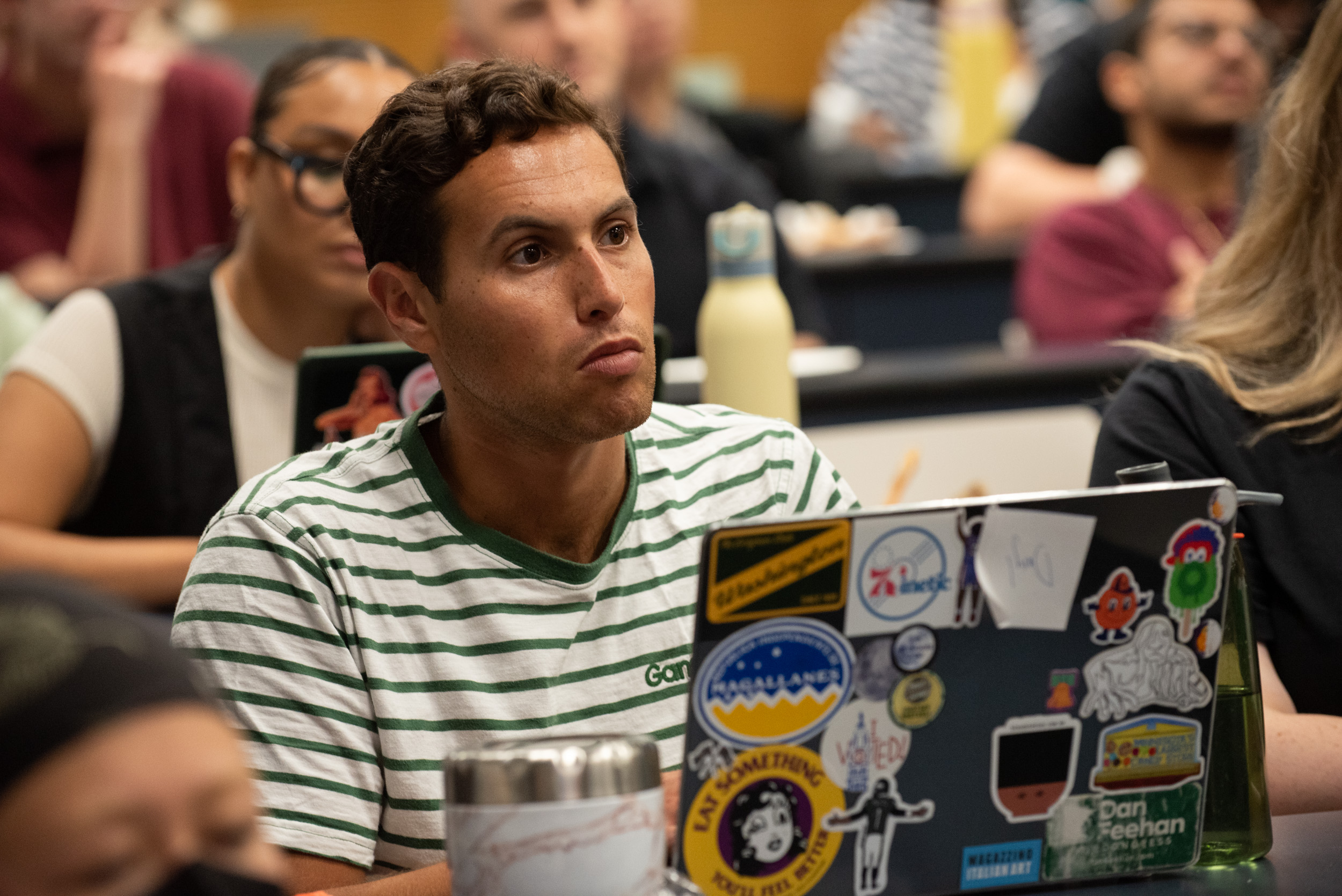Law students and faculty spilled into the corners and rear ledges of Klein Hall’s biggest classroom. The room quickly quieted after Dean Dunoff hushed the beyond-capacity crowd and kicked off the “Supreme Court Roundup.” The panel provided a snapshot of the Court at a moment where longstanding doctrine taught in Constitutional Law a semester ago—in the same, albeit less crowded classroom—teeters on the brink of obsolescence. Professors Purvis, Rangel-Medina and Heath each spoke about the changing landscape within their legal expertise: LGBT rights, immigration and administrative law, respectively.
“Certain Medical Uses”
Professor Purvis began with an overview of U.S. v. Skrmetti, a paradigm shift in equal protection doctrine. The case stemmed from Tennessee’s gender-affirming care ban, which restricted minors from seeking treatment to alter their birth genders.
Writing for the majority, Chief Justice Roberts upheld the limitation by worming his way through the statute, stating that the restriction was placed on minors—a permissive classification (think voting or alcohol)—and levied on only a subset of minors seeking treatment for “certain medical uses.” Because these “uses” are gender-blind, the majority applied the most permissive standard of review, upholding the Tennessee statute and similar restrictions in 26 other states.
The case’s impact may be profound; Professor Purvis opined that the ruling indicates a majority of justices would not categorize sexual orientation and gender identity as classifications deserving of more rigorous court scrutiny, permitting future restrictions on based on only thin justifications that satisfy the “rational basis” standard.
The room burst out in laughter as Professor Purvis displayed her personal copy of the children’s book Pride Puppy, at issue in Mahmoud v. Taylor. Professor Purvis led the group through the oral argument transcripts, parsing through questions on “bondage” and “indoctrination,” which stood in stark contrast to the content of the cheerily illustrated pages. Taylor held that parents must be provided notice of the books taught to their children and the opportunity to opt out of instruction. The decision represents a further datapoint in the court’s increasing solicitude towards faith in public life, chipping away at prior limits insulating public schools from the influence of religion.
“At Large”
Professor Rangel-Medina explored two pending cases challenging the core of the administration’s immigration policy. Trump v. CASA Inc. was brought against the President’s executive order denying citizenship to individuals born in the U.S. to parents without lawful status or present in the U.S. on a lawful, but only temporary basis. The order directly conflicts with a bedrock American immigration principle—birthright citizenship—which grants citizenship to individuals born in the U.S., no matter the immigration status of their parents. This right is expressly mentioned in the 14th Amendment and was considered settled law since it was enacted in 1868.
Nationwide injunctions temporarily halted the order over the summer while the case wound its way through the courts. Before ruling on the merits of CASA Inc., the Supreme Court curbed the ability of federal judges to issue blanket orders that freeze pending legislation beyond the jurisdiction of the issuing judge. As a result, the order is blocked in certain jurisdictions but in effect elsewhere, creating a patchwork that will be resolved only when the Court rules on the merits of the suit.
Noem v. Vasquez Perdomo also awaits resolution. This case stems from the administration’s new deportation scheme: Operation “At Large.” The litigants claim the government is targeting individuals based on racially driven classifications like how they look and speak, rather than using a probable cause standard for deportation.
Professor Rangel-Medina argued that the deportation of lawful U.S. citizens—a hazard of this new strategy—offers a throughline from past to present. She connected the contemporary enforcement regime to historic links between immigration policy and racialized law enforcement, such as the mass deportation of U.S. citizens of Mexican descent in Operation Wetback in the 1950s. The story of Francisco Erwin Galicia, who was detained even with valid immigration papers, demonstrates this unfortunate analogue.
“For cause”
Professor Heath closed the discussion by exploring the seismic shifts in the structure of government. In his remaking of the administrative state, President Trump has stressed hundred-year-old boundaries between executive branch and agency officials.
The principles set in Myers v. U.S. (1926) and Humphrey’s Executor v. U.S. (1935) have stood for generations. The twin precedents draw a distinction between executive branch officials (like the Secretary of State), who serve at the pleasure of the President and may be fired for any cause, and independent agency officials (like a commissioner of the Federal Trade Commission), who are appointed by Presidents to statutorily set terms and may be fired only “for cause.” Many of the challenged firings occurred because of differences in policy and do not involve the typical triggers of a for cause firing like inefficiency or neglect.
Looming above the President’s attempt to cite Myers while firing independent agency officials is a fight for power over the Federal Reserve, a constant thorn in the administration’s side. Under the Humphrey’s Executor threshold, Federal Reserve governors and the chair are protected under the higher, for cause standard. The President’s attempt to remove Governor Lisa Cook by citing unproven allegations of mortgage fraud pushes the limit of what “cause” is.
Troubling for Professor Heath was that much of the Court’s decision-making on these cases appears on the “emergency docket,” which is bereft of the voluminous evidentiary record befitting cases on the merits docket. These decisions are sometimes issued without any explanation or guidance to lower courts, subverting a judicial process designed to foster legitimacy in the Court’s rulings.
Images from October 2025, Temple Law Supreme Court Roundup event


